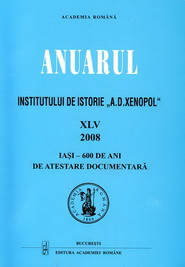Domeniul mănăstirii Humor (1415-1591)
The Estate of Humor Monastery (1415-1591)
Author(s): Arcadie M. BodaleSubject(s): History
Published by: Editura Academiei Române
Keywords: ecclesiastical estate; Humor Monastery; privilege; secularization
Summary/Abstract: At the beginnings of the Humor Monastery, the great founder Ioan Vornic (governor) and his children exercised a protectorate over this institution by administering or exchanging its properties and appointing its abbots. Later on, following the alliance of the dynasty of Moldavia with the descendants of Ioan Vornic, the Humor Monastery gradually turned into a princely foundation and acquired autonomy after 1490 from Ioan Vornic’s family. The monastery estate was created by donations from the villages of the founder and his sons and it grew stronger by the privileges granted by the voivodes Alexander the Good (Romanian Alexandru cel Bun), Stephen II (Ştefan al doilea), Peter Aron (Petru Aron) and Stephen the Great (Ştefan cel Mare). Then, the estate of the Humor Monastery was enriched by some land received from Iurie Şerbescul, Stephen the Great, Bogdan III and Stephen the Younger (Ştefan cel Tânăr). The voivode Alexander Lăpuşneanu (Alexandru Lăpuşneanu) confiscated several properties of the Humor Monastery because the founder's family tried to conquer the throne of Moldavia. Meanwhile, the prince had done the same with the properties of other monasteries given by supporters of the pretender to the throne of Moldavia, Lupu the cupbearer (paharnicul Lupu) (1557). By acts of mercy later given by Alexander Lăpuşneanu, Ioan Despot and Iancu Sasu, the monks of the Humor Monastery managed to recover some of the lost properties: the villages of Feredeieni, Strahotin and Mihăileşti (Drăguşeşti). After conquering the throne, Petru Schiopu, the new voivode, annulled only partially the secularization of ecclesiastical property during the reign of his predecessor, Ioan Vodă. Only towards the end of Peter Şchiopu’s reign did the Humor Monastery estate see a new development, in the form of donations from the boyars, but mostly by creating false documents for expansion into the forest protected area (branişte).
Journal: Anuarul Institutului de Istorie »A.D. Xenopol« - Iaşi
- Issue Year: XLV/2008
- Issue No: 45
- Page Range: 1-29
- Page Count: 29
- Language: Romanian

